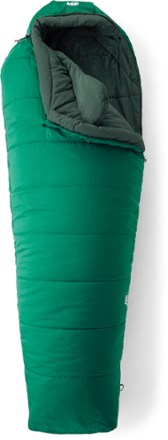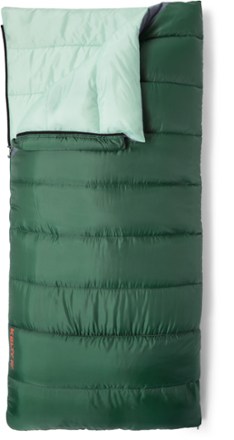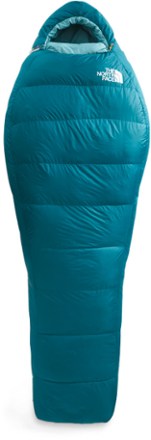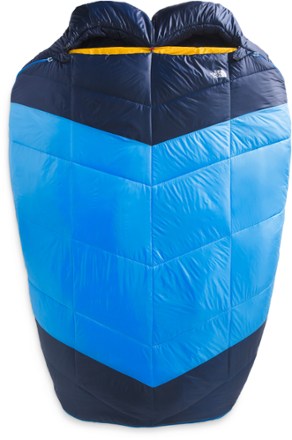What to Wear Hiking
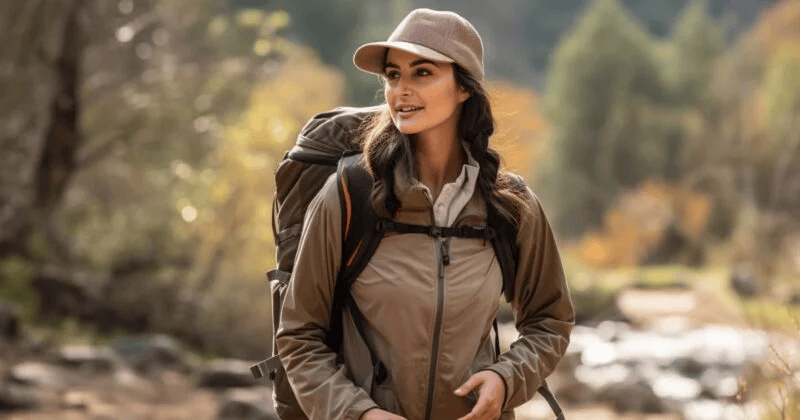
When preparing for a hike, wearing the right clothing can ensure comfort, safety, and an enjoyable experience. Here's a guide to help you choose the best hiking attire, factoring in variables like temperature, terrain, and the duration of your hike.
What to Wear Hiking: A Quick Checklist
Excited to hit the trails? Here's a streamlined list of hiking essentials to help you get out the door and onto the path with confidence:
Comfortable and Sturdy Pants: Look for moisture-wicking and flexible materials like nylon or spandex. Pants should allow for freedom of movement and withstand trail challenges like sharp rocks or branches.
Moisture-Wicking Top: Short-sleeve or long-sleeve shirts made from fabrics such as merino wool, nylon, or polyester work best. These materials will keep you cool and dry by pulling sweat away from your skin.
A Warm Jacket: Opt for a polyester fleece for comfort and warmth.For colder hikes, consider a puffy jacket with synthetic fill or water-resistant down to stay cozy.
A Rain Jacket: Opt for a jacket that's waterproof and breathable, meaning it will block rain and wind, but will also let you sweat without feeling like you're wearing a plastic bag. In seriously soggy weather, pack rain pants too.
A Brimmed Hat and Sunglasses: Protect yourself from sun exposure and rain with a wide-brimmed hat. Add sunglasses for UV protection, especially on open trails or at high altitudes.
Sturdy shoes: Wear hiking footwear that provides support, shields your feet from rocks and roots, and offers good traction. You don’t need heavy-duty boots unless the terrain is rough; lightweight trail shoes or midweight boots work for most hikes.
What Not to Wear Hiking: Avoid These Mistakes
While there’s no strict dress code on the trail, wearing the wrong clothing or gear can lead to discomfort—or even safety concerns. Here’s what to skip when planning your hiking outfit:
Cotton (Including Denim): Why avoid? Cotton absorbs moisture, keeping you sweaty in the heat and cold if wet. Opt for moisture-wicking natural or synthetic fibers like polyester or merino wool instead. Cotton may be fine for short, easy hikes in dry, mild weather.
Clothes You’re Afraid to Ruin: Dirt and sweat can be par for the course while hiking trails, so if there's an article of clothing you'd prefer not to get dirty or wet, it's best to leave it at home.
Improper footwear: Ill-suited shoes can cause blisters, sore feet, or inadequate protection. Skip brand-new shoes for long hikes—break them in first on shorter outings. Avoid casual sneakers, flip-flops, or any shoes lacking support and traction.
Jewelry: Why avoid? Jewelry can snag on branches or gear, get lost, or cause discomfort. Leave anything valuable, loose, or sentimental at home to avoid unnecessary risks or heartbreak.
Overloaded or Ill-Fitting Packs: A heavy or poorly adjusted pack can strain your back and shoulders, turning a fun hike into a chore.
Clothing Strategies for Hiking
Mixing up styles can keep your hiking wardrobe practical yet creative. Let’s explore some key strategies to prepare you for the trail:
- Master the Art of Layering: Layering is your best friend when it comes to unpredictable trail conditions.Foundation: Begin with a moisture-wicking base layer to keep sweat off your skin. Core Insulation: Add a mid-layer like fleece or a lightweight jacket for warmth. Protection: Finish with a waterproof or windproof outer shell to guard against rain or cold winds.
- Fabric Selection Matters: Not all materials are created equal for hiking:Ideal options: Polyester, nylon, and merino wool excel in moisture-wicking and fast drying. What to avoid: Cotton absorbs sweat and dries slowly, which can make you cold and uncomfortable.
- Function First, Looks Second: When you’re miles into a hike, how your clothes feel matters more than how they look. Comfort and performance take priority, but modern hiking gear blends style with function. Choose durable, weather-appropriate clothing that can handle wear and tear while keeping you confident in your outfit.
- Always Be Weather-Ready: Hiking conditions can change fast, so don’t rely entirely on the weather forecast. In colder weather, pack gloves and a warm hat. On summer hikes, go for breathable fabrics and don’t forget sun protection like a brimmed hat or sunglasses. Even on clear days, having a rain jacket in your pack is smart—you never know when a drizzle might hit.
- Match Your Gear to the Trail: Trail type and environment should shape your clothing choices: Dense forests or grassy trails: Opt for long pants and sleeves to guard against ticks and scratches. Dry desert terrain: Lightweight yet sturdy boots and a bandana for dust can be game-changers. Urban trails: A more versatile look—casual yet functional—might work best, blending in as you transition from trail to town.
Understanding Fabrics for Hiking Clothes

The right fabric can make a world of difference when you're out on the trail. Here's a breakdown of key properties to consider when choosing hiking apparel:
- 1. Wicking:
Moves sweat away from your skin to the fabric's outer layer, keeping you dry and comfortable.
Ideal For: Base layers or any apparel in direct contact with skin.
Merino wool: Naturally wicks moisture and resists odor.
Synthetic fibers: Polyester and nylon wick effectively and dry quickly, though they may retain odor over time.
- 2. Insulating:
Retains body heat to keep you warm. Clothing itself doesn’t produce heat but traps the warmth your body generates.
Ideal For: Mid layers like fleece jackets or insulated puffies.
Fleece: Lightweight and breathable, great for active use.
Down or synthetic fill: Excellent insulation, with synthetic being better for wet conditions.
- 3. Waterproof and Windproof:
Protects against rain and wind, keeping you dry and warm by blocking moisture and heat loss.
Ideal For: Outer layers or shells.
Waterproof jackets: Typically also windproof, though it may not always be explicitly stated.
Water-resistant jackets: Offer moderate protection but won’t hold up in heavy rain or strong wind.
- 4. Breathable:
Ensures moisture from wicking layers evaporates efficiently, preventing you from feeling damp or overheated.
Importance: Essential for all layers to balance comfort during exertion.
Challenges: Advanced waterproof/breathable shells can still struggle in humid conditions or intense activity.
- 5. Waterproof/Breathable Combo:
Combines rain and wind protection with breathability.
Ideal For: High-performance outer shells in variable weather.
High-tech shells: Expensive but effective in moderate exertion.
Coated nonbreathable shells: Budget-friendly but can trap heat and moisture, leading to discomfort.
- 6. Sun Protection:
Shields your skin from harmful UV rays.
Ideal For: Any environment, from alpine to desert.
Clothing with an Ultraviolet Protection Factor (UPF) rating.
Lightweight, long-sleeve options to cover exposed skin.
Basic Fabric Choices for Hiking and Outdoor Apparel
Different fabrics serve unique purposes when you're gearing up for the outdoors. Here's an overview of popular options, their benefits, and their drawbacks:
- Wool, especially modern merino wool, has transformed into a soft, lightweight, and breathable fabric. It wicks moisture effectively, dries relatively quickly, and naturally resists odors, making it a popular choice for base layers, socks, and cold-weather clothing. However, its higher cost compared to synthetic options might be a drawback for some..
- Polyester and nylon are affordable and highly efficient at wicking sweat and drying quickly. Many products made from these materials incorporate recycled components, making them environmentally friendly. However, they can develop unpleasant odors during use, though some garments address this with antimicrobial treatments. These materials are versatile and commonly used in everything from basic apparel to protective outer shells like rain jackets.
- Fleece, a type of polyester fabric, is widely used as an insulating mid-layer. Its soft, thick fibers trap warmth efficiently, making it an excellent option for colder weather. While it shares some moisture-wicking properties with other synthetics, its main appeal lies in its lightweight warmth and comfort.
- Silk, while luxurious and soft, is not the most practical choice for outdoor adventures. Its modest wicking ability makes it less ideal for strenuous activities. Treated silk performs slightly better, but its lack of ruggedness and odor resistance limits its use for hiking or intense outdoor conditions.
- Cotton: Cotton is generally not recommended for outdoor apparel due to its inefficiency in wicking moisture and drying. It tends to soak up sweat, remain wet, and leave you feeling clammy. In cold conditions, this can lead to chilling or even hypothermia. While it might work in hot and dry environments for short hikes, it is rarely a reliable choice for outdoor adventures.
Layering Basics
Base Layer
The base layer is crucial for maintaining comfort as it sits directly against your skin and serves to manage moisture.
- Underwear should prioritize comfort and functionality, with breathable, moisture-wicking, and non-chafing materials like seamless designs being ideal for longer hikes.
- Bra: Choose a supportive sports bra that matches your size and activity intensity is essential for both comfort and stability.
- In colder conditions, wicking Long Underwear acts as a reliable base layer for your legs, worn under hiking pants or rain pants when weather turns stormy. These come in varying weights—lightweight, midweight, and heavyweight—allowing you to tailor your choice based on expected temperatures and personal comfort.
- For Shirts, short-sleeve or long-sleeve wicking tops are versatile, with UPF-rated options providing additional sun protection. It’s best to avoid tank tops when wearing a backpack, as straps can cause chafing.
- Pants and bottoms should be moisture-wicking and flexible, with hiking pants or leggings being popular choices. Convertible pants offer the flexibility of switching between shorts and full-length pants. Quick-drying fabrics are key, and some hiking shorts with liners can even double as swimwear. However, consider the risks of exposed legs, like sunburn or bug bites, and opt for pockets for easy storage. In colder weather, replace standard hiking pants with long underwear as your base layer for added warmth.
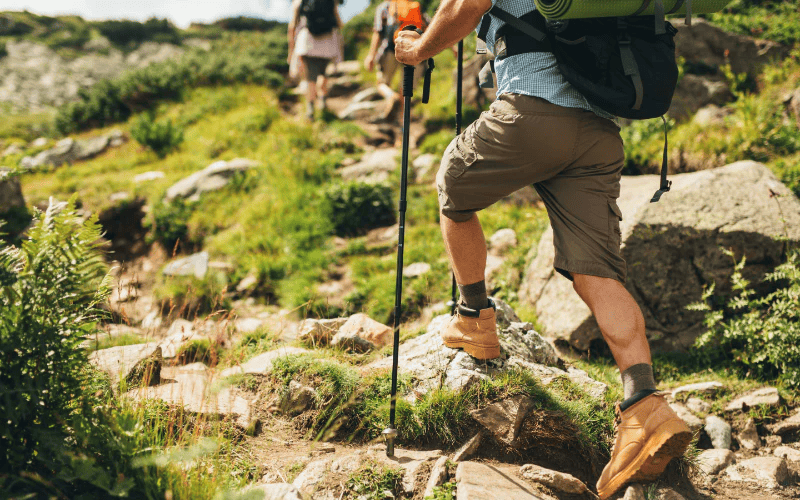
Mid Layer: Fleece and Puffy Jackets
This layer is essential for providing warmth, with flexibility to adjust based on your hike's conditions. Here’s a breakdown:
- Fleece jacket: Ideal for colder days when you need warmth while hiking or during rest breaks. Available in lightweight, midweight, and heavyweight options to suit varying temperatures and personal preferences.
- Fleece pants: Useful in extremely cold conditions as an additional layer for leg warmth, though long underwear bottoms often suffice for most hikes.
- Puffy insulated jacket or vest: A must-have for cold conditions. Puffy jackets are available with standard down, synthetic insulation, or water-resistant down. Synthetic options or hybrids with water-resistant down are more reliable in wet conditions, while standard down is best for dry, cold environments.
Outer Layer
Your outer layer serves as essential protection from unexpected weather changes, such as sudden rain or strong winds. Staying dry and shielded from the elements is crucial for maintaining comfort and safety during your hike.
- Shell/Rain Jacket: Options include soft-shell, hard-shell, and hybrid-shell jackets, each offering a different balance of waterproofing, insulation, and breathability. For lightweight or budget-conscious hikers, a poncho might work as a quick solution, but it provides limited protection during prolonged rain..
- Rain Pants: In conditions with heavy or sustained rainfall, rain pants are indispensable. Prioritize options that offer both breathability and flexibility to keep you comfortable while staying dry.
Footwear
Choosing the right footwear is crucial for a comfortable and safe hike. Ill-fitting shoes can lead to blisters or sore feet, making it harder to enjoy the journey.
- Hiking boots or trail-running shoes: Choosing the right footwear for hiking is crucial. Sturdy shoes provide foot support, protection, and traction, especially on uneven surfaces. Waterproof or water-resistant shoes are great for wet or muddy conditions, though they may compromise breathability. Hiking boots, offering more ankle support, are recommended for longer or multi-day hikes, while lighter trail-running shoes are better suited for shorter, well-maintained trails.
- Hiking sandals: Hiking sandals have come a long way from flimsy flip-flops. These lightweight, breathable shoes are perfect for water crossings or hot weather, especially on flatter terrain. Look for sandals with good support, grip, and a secure strap system to ensure a comfortable and stable fit throughout your hike.
- Socks: Socks are a crucial part of your hiking gear. Choose socks based on the weather and the fit of your footwear. For optimal comfort, go for moisture-wicking wool socks instead of cotton, which can cause blisters when wet. Make sure your socks are tall enough to prevent friction with your boots and prevent discomfort or injury.
Hiking Accessories
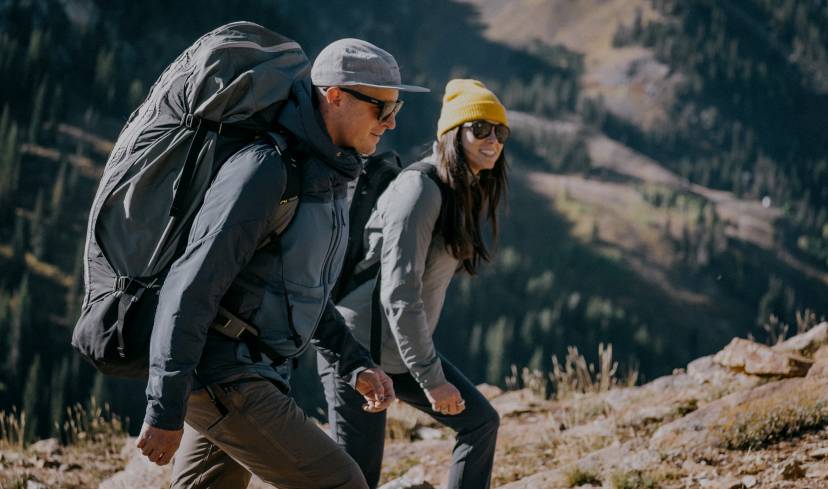
Once you're dressed for the hike, it's important to consider a few additional accessories that will keep you protected from the elements and ensure comfort on the trail.
- Hats: A hat is useful in any season to shield your face from the sun, wind, or rain. If you're hiking under intense sunlight, opt for a wide-brimmed hat or a billed cap to protect your face. In desert conditions, you might consider adding a sun cape for extra neck protection. For cooler weather, a wool or synthetic cap will help keep your head warm..
- Sunglasses: A quality pair of sunglasses will protect your eyes from harmful UV rays and keep them shielded on windy days. Polarized lenses help reduce glare, although they may cause some blind spots. Photochromic lenses transition between dark and light shades depending on the surrounding light, offering versatility for varying light conditions.
- Gloves: The type of gloves you need depends on the weather. In cold conditions, insulated gloves or mittens are essential to keep your hands warm, with mittens typically offering more warmth than gloves. Waterproof gloves are ideal for snowy or rainy weather.
- Leg gaiters: Leg gaiters fit over your boots and pants to protect your legs from trail debris, water, and even pests like ticks. Waterproof gaiters are especially useful in wet or snowy conditions, providing additional protection to keep your feet and legs dry.
- Neck gaiters: Neck gaiters can keep you warm in cold weather with fleece or wool options, while lightweight, breathable versions are great for sweat absorption and UV protection in warmer climates. They are a versatile accessory to ensure comfort throughout your hike.
- Daypack: Although not technically clothing, a well-fitting daypack is an essential accessory for any hike. A lightweight pack will allow you to carry water, snacks, extra layers, and other essentials. For short hikes, a basic bookbag might suffice, but for longer hikes, a more technical pack with added features like water resistance, extra back support, and a hip belt can be much more comfortable and practical.
Sustainability Features
From your base layer to your leg gaiters, every product has an environmental, social and/or animal-welfare footprint. By considering the following choices, you may be able to minimize that impact. For more in-depth consideration on sustainable hiking apparel, see How to Understand Clothing and Gear Sustainability Features.
Use what you already have: Especially when you're just starting out, taking shorter hikes or staying on close-to-home trails, you may be able to make do with what's already in your wardrobe. Pick through your favorite gym clothes and most comfortable apparel to see what trail-ready items you already have.
Buy secondhand: These days, you can buy high-quality outdoor hiking clothes and gear secondhand at consignment shops or online retailers. REI Co-op Members can shop for and trade in used clothing and apparel through the co-op's Re/Supply program.
Invest in quality: If you do invest in new (or new-to-you) clothing items, consider buying durable, well-made pieces that are meant to last, and learn how to care for and store them to lengthen their lives. See our Care and Repair article library for tips and tricks.
Repair your apparel: Curb consumer demand for new stuff by choosing to extend the life of your hiking footwear, gear and apparel via repairs. See our Care and Repair article library for specific gear and clothing repair guides.
Look for bluesign®-certified apparel: The bluesign® certification recognizes companies that have made significant efforts to prevent harmful substances from entering the production process. It follows a robust auditing system that evaluates pollution, resource use, consumer safety and occupational health and safety. For more details, read What is bluesign®?
Purchase products made from recycled materials: Give pre-used materials a new lease on life by buying hiking clothes and gear that are made from recycled, remnant or repurposed materials. Recycled polyester, sourced from recycled plastic bottles, is a common material for shells and fleece jackets, for instance. Read more: Understanding Recycled Materials in Outdoor Clothing and Gear.

